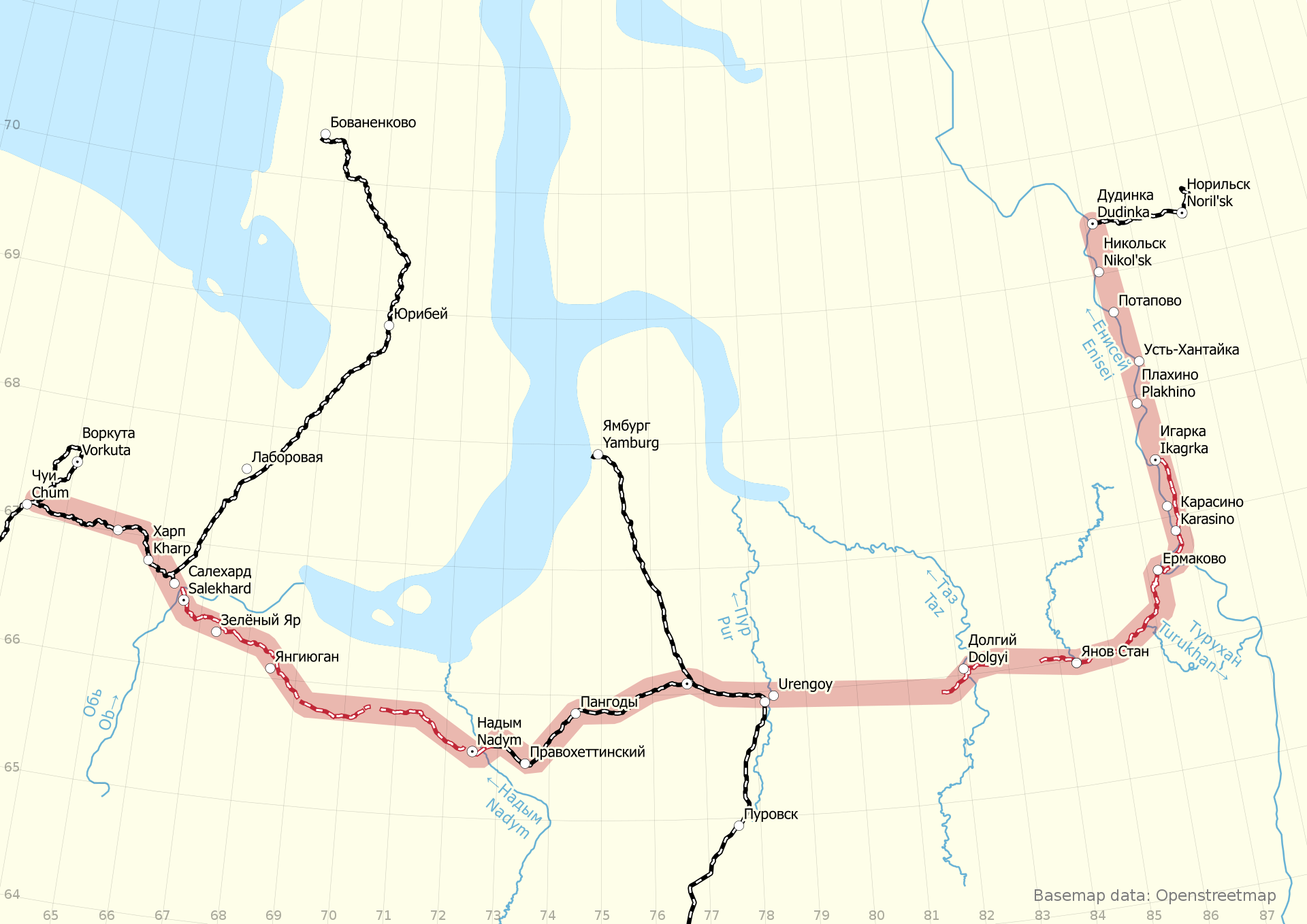Russia resumes mega project: connecting North Sea Route with Indian Ocean by rail
29 October 2021
Russia is resuming the implementation of an ambitious railways project, which should connect the ports of the Pacific and Indian Oceans with the Northern Sea Route. The project was put on hold during the pandemic, but was resumed last month with new financial impetus from RZD, Russian Railways’ subsidiary.
The project, which is known as Siberian Meridian, includes both already planned construction sites such as the Northern Latitudinal Passage, and new thousand-kilometer lines in Siberia and the Arctic. These lines should connect to the already existing network, which links Russia to the rest of the world. Via the North-South Transport Corridor it is linked by rail all the way up till the south of Iran. With the Arctic and Siberian regions included, North Sea is added to this network. The overall cost of the project is estimated at 4.9 trillion rubles (US$65 billion).
Centre of Eurasia
As part of the project there are plans to build a rail freight link between China and Arctic seaports on the Northern Sea Route (NSR), bypassing the Trans-siberian corridor. These railway lines would cover large sections of Siberia and the Arctic region.
The project was for the first time put forward by Russia’s president Vladimir Putin in October 2019. He then called the region of Eastern Siberia “the centre of Eurasia”, as it could be the link between the seas.
Apart from taking off pressure from the Trans-Siberian corridor, an already heavily consumed railway line, the Siberian Meridian should provide transport facilities for the first clusters of the Angara-Yenisei macroregion and help develop the Russian Arctic and Siberian regions.

Depending on the money
The trigger to resume the project was a statement of RZD in September. The Russian Railways subsidiary published a draft of a long-term investment programme, including an increase in investments by 800 billion rubles during the period of 2022-2025. Of these, 150 billion rubles will be allocated to the building of Northern Latitudinal Passage – one of the major sections of the Siberian Meridian.
An official spokesman of RZD told RailFreight.com that the company is ready to begin implementation of the project, however, much will depend on financial resources. “The actual implementation of the project will depend on the parameters of the investment programme of Russian Railways, which is approved by the Government of the Russian Federation”, he indicated.
Additional funding
In fact, there is a plan for additional funding for the project through infrastructure loans that will be provided by the state to Russian regions. In August, the Ministry of Economy announced the possibility of funding the project from the National Welfare Fund (NWF), one of Russia’s largest public investment funds.
However, according to analysts of the Russian GoArctic paper, one of the country’s leading papers dedicated to the Arctic region, despite optimism of the state, implementation of the project may face serious difficulties of both technical and other origin.
Possible investors
They believe building in the Arctic is difficult and expensive, while payback periods in the North are sometimes tens of years. In this regard, the state will become the guarantor for implementation of the project, although it will probably take steps for the attraction of private investors on the later stages of the project. According to some Russian media reports, the project may involve participation of Gazprom and other hydrocarbons’ majors.
Analysts also believe implementation of the project could have a particular importance nowadays, mainly due to the ever-growing shipping costs worldwide, which puts a serious pressure on global economics and trade.
Railway density today
In the meantime, Russia has achieved some major successes in recent years developing its railway network in its Northern territories. Already now, the density of railways in the Russian North is higher than the average for Russia. In Karelia, for example, there are 123 km of roads per 10 thousand km², which is 2.5 times higher than the average.
At the same time, the situation in the eastern regions of the Russian Arctic are far from the same. In Yakutia, the density of railways is 25 times lower than the average, in the Yamalo-Nenets Autonomous Okrug – 8.3 times, in the Krasnoyarsk Territory – 5.6 times.
morenews
Programme of #ESRS2023 is complete: Meet our speakers
– 3 November 2023 – The programme of the European Silk Road Summit in Budapest is complete! With 23 speakers from all over the world, the 7th edition of this industry event is set to become a success. The European Silk Road Summit, which is taking place from 29 November to 1 December in Budapest,… Read more ›
Deli Andor, Member of the European Parliament to speak at #ESRS2023
– 23 October 2023 – With just over a month to go until the European Silk Road Summit will be held in Budapest, Hungary, the list of knowledgeable speakers is growing fast. Deli Andor, who is a Member of the European Parliament, Dmitrij Hasenkampf from RTSB, Rashad Majidov from ADY Container and Zoltan Kozlovszky from… Read more ›
Nominees for RailFreight Ambassador 2023 announced
– 20 October 2023 – We are proud to announce the nominees for the RailFreight Ambassador 2023! Four industry professionals with extensive knowledge and experience in rail on the Eurasian corridor received the confidence of the industry. It is time to vote now! The nominees of the RailFreight Ambassador Award of 2023 are: Juergen Huschka… Read more ›
